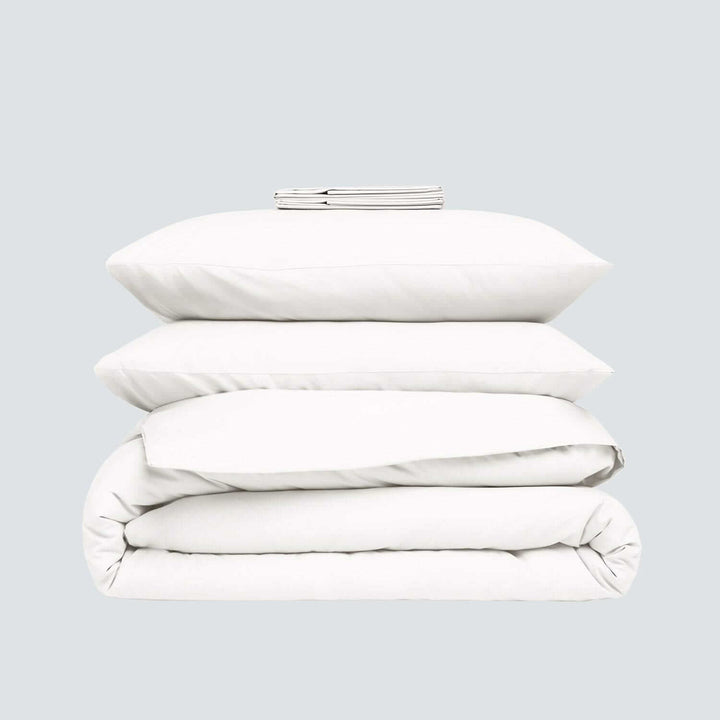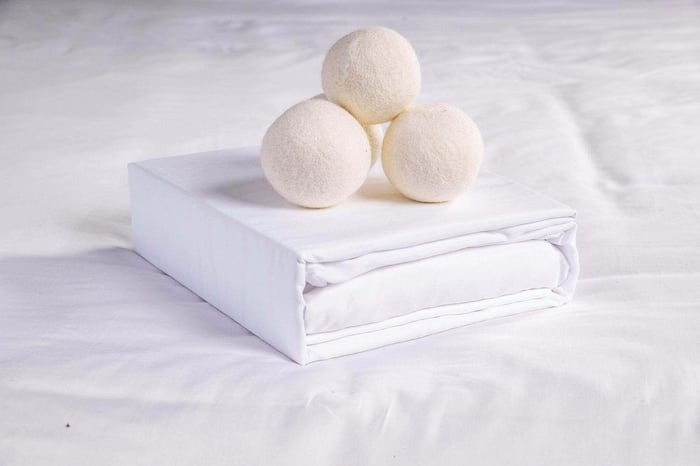Table of Contents
- When “Clean” Bedding Isn’t as Clean as It Looks
- The Hidden Allergy Zone: Why Bedding Traps Dust Mites
- Wool: Nature’s Built-In Defense System
- What Science Says About Wool and Allergens
- Comparing Common Bedding Materials
- Regenerative Wool: A Step Beyond Hypoallergenic
- Breathability and Airflow: Why It Matters for Allergies
- Wool vs. Treated “Anti-Allergy” Bedding
- Care Tips: Keeping Hypoallergenic Wool Bedding Fresh
- Sustainable Comfort: Wool’s Environmental Advantage
- Cool, Clean, and Naturally Protected
- FAQs on Wool Duvet Inserts, Comforters & Sustainable Bedding
When “Clean” Bedding Isn’t as Clean as It Looks
If you wake up with a stuffy nose, itchy eyes, or a scratchy throat, it might be time to switch to hypoallergenic bedding. Dust mites—microscopic insects that thrive on skin flakes and humidity—are one of the most common triggers for nighttime allergies, and they flourish inside conventional bedding.
But there’s good news: nature has already designed the perfect defense.
Among all hypoallergenic bedding materials, wool stands out as one of the most effective natural protectors against dust mites, mold, and mildew — no synthetic treatments required.
Let’s look at what the science says about how wool resists allergens, why it outperforms other fabrics, and how it helps create a truly healthy sleep environment.
Learn More in our Ultimate Hypoallergenic Bedding Guide
The Hidden Allergy Zone: Why Bedding Traps Dust Mites
Your bed is a warm, dark, and humid space — ideal for dust mites.
These microscopic creatures thrive in temperatures between 68°F and 77°F, feeding on the skin flakes humans naturally shed at night.
Conventional bedding materials like cotton, down, and polyester trap moisture and warmth, creating a perfect breeding ground. Over time, dust mite waste particles (the true allergen) accumulate inside comforters, duvets, and pillows — causing sneezing, congestion, and poor sleep quality.
That’s where hypoallergenic bedding comes in. Instead of relying on chemical anti-mite sprays, it uses natural fiber science to make your sleep space inhospitable to allergens.
Organic Wool Duvet Insert & Bedding Set | Sustainable & Regenerative | Made in New Zealand

$475.15
$559.00
Cooler Nights & Deeper Sleep — All Year Long Looking for the perfect organic wool duvet insert and wool bedding set? This complete bundle includes both the duvet insert and cover. (The insert uses the same breathable, temperature-regulating design as… Read more
Wool: Nature’s Built-In Defense System
Wool isn’t just breathable — it’s naturally dust mite resistant.
Each wool fiber has unique structural and biochemical properties that repel moisture, dust, and bacteria.
1. Wool’s Crimped Fiber Structure
Unlike flat cotton fibers, wool fibers are crimped and spring-like, forming microscopic air pockets that allow air to circulate.
This natural airflow prevents the warm, damp environment dust mites need to survive.
2. Lanolin: Nature’s Protective Coating
Wool contains lanolin — a natural waxy substance secreted by sheep. Lanolin is antimicrobial, meaning it discourages bacteria and fungi from taking hold. This biological coating helps make wool bedding hypoallergenic without the need for synthetic chemicals.
3. Moisture Regulation
Wool can absorb up to 30% of its weight in moisture vapor without feeling damp. That means your bedding stays dry to the touch even if humidity rises — and since dust mites need moisture to live, they can’t survive in wool’s microclimate.
4. Temperature Regulation
Wool fibers adapt to body heat, keeping sleepers cool when it’s warm and warm when it’s cool. This temperature-regulating property further limits the conditions dust mites depend on.
What Science Says About Wool and Allergens
Numerous studies have confirmed wool’s natural resistance to dust mites and allergens.
Studies show that controlling humidity, using allergen-proof encasements, and regular hot washing are the most effective ways to reduce dust mites; breathable, moisture-balancing fibers like wool can help keep the sleep microclimate drier, which is less hospitable to mites.
Research also shows that individuals with asthma or eczema experience fewer flare-ups when sleeping under hypoallergenic wool comforters, largely due to better humidity control and reduced bacterial growth.
In short, wool creates an unfriendly habitat for dust mites — without synthetic chemicals or allergen-resistant coatings that can irritate sensitive skin.
Organic Wool Comforter | Made in New Zealand, Breathable All-Season Comfort

$342.00
$380.00
Sleep naturally better with our organic wool comforter Unlike down or synthetic comforters that trap heat, our spun wool design wicks away moisture and prevents overheating, so you stay cool & dry. Designed for deeper sleep with a gentle weight… Read more
Comparing Common Bedding Materials
| Material | Dust Mite Resistance | Moisture Control | Breathability | Hypoallergenic | Sustainability |
|---|---|---|---|---|---|
| Wool (Regenerative) | Excellent | Excellent | Excellent | Yes | 100% Renewable |
| Organic Cotton | Moderate | Good | High | Yes | Renewable |
| Down / Feather | Poor | Low | High | No | Moderate |
| Bamboo Viscose | Moderate | Moderate | Good | Partial | Chemically Processed |
| Polyester / Microfiber | Poor | Low | Low | No | Non-renewable |
Wool clearly leads the pack — not just for being hypoallergenic, but also for sustainability and comfort. Its renewable origin and low environmental impact make it a standout for those who want bedding that’s as kind to their body as it is to the planet.
Regenerative Wool: A Step Beyond Hypoallergenic
At Antipodean Home, our wool comes from regenerative New Zealand farms that prioritize soil health, biodiversity, and animal welfare.
This type of farming produces wool with organic integrity — free from pesticides, harsh detergents, or chemical mothproofing.
The result: hypoallergenic bedding that’s not just safe for sensitive skin but restorative to the ecosystems that produce it.
When you choose regenerative wool bedding, you’re doing more than avoiding allergens — you’re supporting a cycle that restores what’s been depleted.
Sustainable & Regenerative Bedding Bundle | No More Night Sweats, Just Deeper Sleep

$598.40
$748.00
Cooler Nights & Deeper Sleep — Every Night Elevate your sleep with the only sustainable bundle crafted from regenerative New Zealand wool and organic cotton for true all-season comfort. These breathable, eco-friendly fibers naturally wick away heat and moisture to… Read more
Breathability and Airflow: Why It Matters for Allergies
Allergic reactions are often triggered by stagnation — still air, trapped humidity, and buildup of organic debris.
Wool’s breathable structure ensures constant airflow, reducing both allergens and bacteria. This breathability also benefits hot sleepers, who often experience both overheating and allergic reactions from synthetic bedding.
Compared to cotton or bamboo, wool’s natural loft and fiber elasticity help maintain an open structure that resists clumping — so your hypoallergenic bedding keeps breathing year after year.
Wool vs. Treated “Anti-Allergy” Bedding
Many “anti-allergy” bedding products on the market use chemical coatings to repel dust mites and mold.
But these treatments can break down after washing — and sometimes release volatile organic compounds (VOCs) that can worsen indoor air quality.
Wool, by contrast, is naturally non-toxic, free of off-gassing, and retains its protective properties for decades without synthetic additives.
If you’re looking for non-toxic bedding that protects both your health and home environment, wool bedding offers an elegant, enduring solution.
Care Tips: Keeping Hypoallergenic Wool Bedding Fresh
To maintain the dust mite resistance and structure of your wool bedding:
Air it out regularly. Fresh air rejuvenates wool fibers and removes moisture naturally.
Spot clean instead of machine washing. Wool’s lanolin repels dirt, so most spills can be wiped away.
Use a breathable cover. Pair your wool comforter with an organic cotton duvet cover to protect against surface dust.
Avoid plastic storage. Store in a cotton bag to allow airflow when not in use.
Refresh occasionally. A day in indirect sunlight helps eliminate odors and resets wool’s natural properties.
With minimal care, high-quality wool comforters can last decades while retaining their hypoallergenic performance.
Sustainable Comfort: Wool’s Environmental Advantage
While synthetic bedding requires fossil fuels and sheds microplastics, wool is both biodegradable and carbon-sequestering.
Regenerative farms build soil carbon with every season, meaning your comforter actively contributes to a cooler planet.
That’s what makes regenerative wool bedding unique: it’s cooling for you — and for the Earth.
Cool, Clean, and Naturally Protected
When it comes to allergies, prevention starts where you sleep.
Wool’s natural dust mite resistance, breathability, and moisture control make it the ultimate choice for hypoallergenic bedding — one that supports both wellness and the planet.
While synthetic “anti-allergy” fabrics rely on coatings and chemicals, wool quietly works with nature’s own design — protecting you while you rest.
Because true comfort isn’t just about softness.
It’s about waking up clear-headed, calm, and breathing easy.
Discover How Wool Is The Best Hypoallergenic Bedding
FAQs on Wool Duvet Inserts, Comforters & Sustainable Bedding
Is wool bedding really hypoallergenic?
Yes. Wool’s natural fibers resist dust mites, mold, and bacteria, making it one of the most effective hypoallergenic bedding materials.
Can wool cause skin irritation?
High-quality wool, especially fine Merino or ZQ-certified regenerative wool, is soft and gentle on sensitive skin — far less likely to irritate than synthetic fabrics.
How does wool compare to “anti-allergy” synthetics?
Wool is naturally dust mite resistant without coatings or chemicals that wear off over time.
Can I use wool bedding if I have asthma or eczema?
Yes. Studies show wool’s breathability and moisture control can reduce flare-ups in both conditions by keeping your sleep environment dry and clean.
How often should I clean wool bedding?
Wool requires less frequent washing — regular airing keeps it fresh. Overwashing can strip its lanolin and reduce performance.
What makes regenerative wool different?
It’s produced on farms that prioritize soil and animal health, ensuring fibers are purer, softer, and free of synthetic residues — ideal for hypoallergenic bedding.




